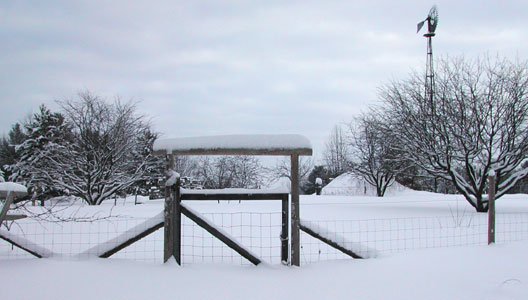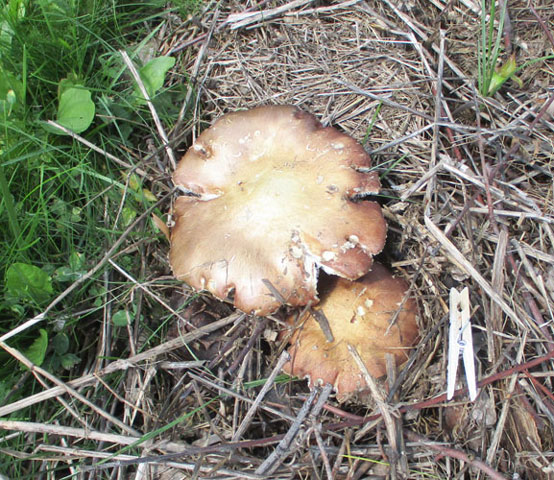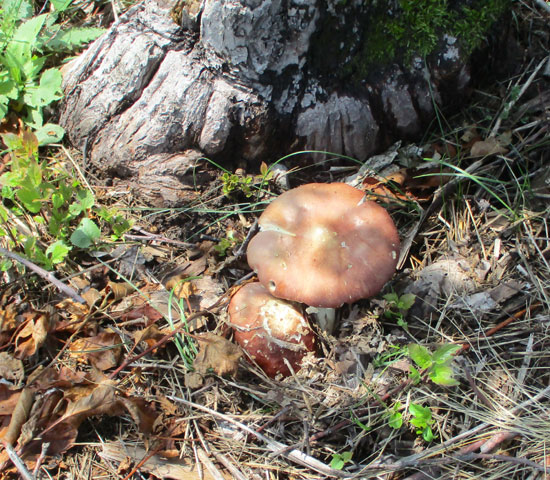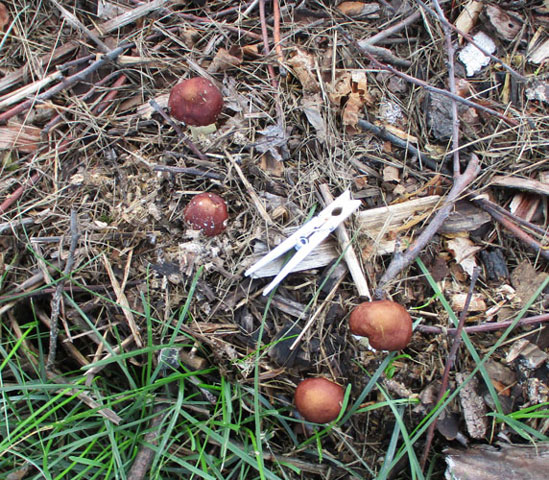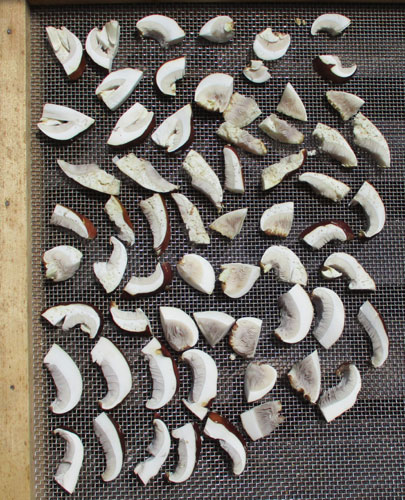|
| |||
|
Apples
Blueberries |
Beacon Apple
University of Minnesota Hort. Research Station originally MN423, introduced 1936
planted 1977 -- on unknown rootstock, but possibly
standard seedling. First apples 1987.
|
Akero |
Hoholik |
|
1997 - Prairie Spys. That's what we were
told they were when we planted them almost 50 years ago. So that's what they
were for all those years. Our large, standard, venerable, reliable (sort of)
much appreciated PS apple trees, #'s 1, 2, and 3. They were the only apples we
had other than wild ones for many years. Then not too long ago I discovered that our trees were not what is ca 2025 Beacon North - Took off large NW low limb and quite a bit upper center, and other mostly large uprights. N still need more thinning next year. End August dropping a few good apples plus 2nds. Moderate crop, mostly in N (oldest) area. Sept.8 dropping good apples. Sept.11 picked 2 crates - 44# - nice apples. Most mixed with Dudley for cider, and some sauce. They weren't as sweet this year, possibly due to wet, overcast season with little sun. Beacon South - Took off several medium size branches and quite a bit of thinning to open the tree and for better balance. N needs more next year. Not much done on Starkey. Only a couple apples on either. 2024 Beacon North - Removed large upper east limb that had significant sunscald on top. Did a lot of pruning on the south Goodland side, removing Beacon originals to encourage and give room to the Goodland grafts. Also took off a number of upper growers at top and too-low branches. Will do more on the north side next year. It's much more open now and looking better. Beacon South - Cut back a lot of top including top of Starkey. Hard to get a good shape but did many thinning cuts, especially the overcrowded south. Looking more open. Both trees had decent medium crop, dropping half bushels end of August. Picked last nice 1 1/2 pecks 9/8. Lots of drying, fresh eating and fresh sauce (along with Dudley). Mix of Beacon and Dudley made 3 batches of delicious cider Sept. 18-22 (about 50 qts). We sure do appreciate these trees that are dear to our hearts, and our bodies! 2023 Beacon North - Continue with shaping, thinning for better air circulation, removing some low growers, making space around Goodland grafts on south. Did well in spite of the drought. Had scattered fireblight and tip blight strikes, cut out when noticed. It was a very good year for apples! A full crop pretty much all around the tree; did a lot of thinning. Started dropping about August 26, healthy beautiful fruit. Bumper crop. 8/31 had a full half-bushel from one day's drops. Picked the last half bushel Sept. 12. Beacon South - Doing very well, splits on trunk and limbs healing. Did moderate pruning. Challenge to manage vigorous Starkey at top (which set fruit for first time this year), making room for both. Filled in some around roots/trunk to make it easier to manage. Had a number of mushrooms growing but no A.mellea. Even had a few Winecaps appear in the grass around the tree. B.South set a moderate crop, healthy with just a small amount of watercore. Very nice harvest along with North. Together we ate a lot fresh, make sauce, dried slices, made a lot of cider (mixed with Dudley). South's apples were done Sept. 9, a few days before North's. The last of the apples went in the last batch of cider Sept. 25. Their season is short but it is prolific! 2022 Beacon North - Did a lot of shaping and cutting off uprights in April pruning, quite a bit cut out and it is looking better. End of May the north and east, older limbs side is full of blossoms; south area scattered and west just a few. Overall it looks possible for a good harvest this year. Had some blossom blight (in other trees, too, this year) - kept eye out for and pulled off as found.
August 19 -
Now, after many years of challenging pruning, this wonderful tree is finally gaining some equilibrium and sense of self. There are many apples growing on the east and west sides now (including a full grafted branch of Goodlands). And the south side is reaching out nicely to balance that thicket of old growth on the north. Next year I'll start cutting back the north side to finish the reshaping. It's been a long-term renovation but well worth it. It shows just how adaptable and agreeable apple trees can be as they do their best to accommodate the idiosyncrasies of their humans. It gave a good crop of really nice apples this year Beacon South - In April I cut out center (top was dead) down to the Starkey graft limb (which is nicely growing upwards). A lot of splits in the trunk but the branches look good, and the splits seem to be healing. Sprayed well with Neem Oil before leaf growth, and later with fermented comfrey/spinach. End of May it is full of blossoms. Leaves took good (better than Starkey which looks a bit rough). Added new Winecap spawn and mulch around base, but only a few Winecaps grew. Maybe spawn froze early, maybe too dry (I didn't think to water during drought), or possibly there just wasn't enough of the woody mulch that they like. We did have some other non-parasitic mushrooms growing around tree. Unfortunately, the end of October I found a big clump of what I assumed, once again, was Honey Mushrooms on west side in mulch/grass area. Dug out, disposed of. But first did a spore test on gray paper, expecting the reported white spore. But it was a golden color. I searched online but couldn't find any ideas about that. The mushrooms sure look like A.mellea, and the tree certainly has signs of what appears to be that type of parasitic damage, but all descriptions say white spore print. They also say there is a ring around the stem. There was no ring around these stems. OK, what have we here? I don't know why I didn't think to do a spore print previous years, but then I have never before cared to ID a mushroom (just enjoyed admiring them). Trying to ID via photos online is as bad as trying to ID an apple by photos of the fruit. I did find Gallerina marginata to sound possibly close. The spore print is rusty gold. It's saprobic, and very poisonous (not an issue - I have no intention of eating it). They say it often grows closely with A.mellea, and is common. Maybe I'll find some knowledgeable person to help me figure this out someday. For now all I can do is help to keep the tree healthy and hope it can overcome whatever the issue is on its own. Overall it is looking much better. Later on a hike we found some nice Turkey Tails on a small limb fallen on the path. Brought it back, sawed in pieces and stuck here and there around stump and tree. Maybe they will take to the tree and crowd out any parasitic mushrooms, whatever they may, or may not, be. It is my hope. HARVEST - Both trees tarted dropping good apples first of September. I picked up apples daily then mid Sept. picked a hb of ripe ones off each tree (wanting them to store better without dropped bruises). Still some left. 9/20 harvest was about done. I figured about 12 bushels total off the two trees, for cider, sauce, fresh eating. To say we appreciate these old friends and what they've given to us is an understatement! 2021 Beacon North - April pruning continues to be significant, thinning and shaping and removing uprights. But the growth is slowing somewhat now and the tree is developing a shape, unique to itself but looking more like a fruit tree than an out-of-control porcupine. The north and east sides were full of bloom end of May, as were the older Goodland graft south-east. Looking good. Then came the end of May freezes. But in spite of that major setback and a major hot summer we got about a peck of nice fruit September 9-12 with just a small amount of watercore. Beacon South - April 8 - Phase 2 of my help-the-tree-recover (ideas based mainly on the California research article: Non-chemical control of Armillaria mellea infection of Prunus persica - and my guess that we had Armillaria mellea.) First part - inside the dug-out area (left open all winter) I tossed in pruning “twigs” (thinner pieces cut to short lengths) plus some soil from under a healthy wild apple. I’ll add some more pruning pieces later. Second part is a Winecap Mushroom “bed” around the tree, mulching the sod. Will add purchased spawn when freezes are likely over. Using what I have, from the bottom: cardboard - old rotting hardwood branches (to hold the cardboard down since it was windy but figure they might be useful) - pruning twigs/small branches - buckwheat straw/hay from last season - some wood chips from last year - hardwood rough sawdust from fall sawing. I’m pretty sure I can get some this-year’s roadside chips so I’ll add that and more pruning stuff later. Basically a make-do hodge-podge of ingredients that I hope the Winecaps will “make-do” with. I also pruned the tree to make sure it has plenty of air circulation. Third part - yet to be done - is to entice some wild TurkeyTail mushrooms onto the dead part of the stump. I happen to have some growing on a low ground level apple stump. Haven’t figured out just how to “move” it but that’s next. I’m thinking to scrape off all I can into a bucket, mash it up maybe with some sawdust, mush it into available crevises. We’re into a rainy spell now which I figure is good time to do it.
It turned out that the poles and large sticks were not a good idea. The mushrooms (and yes, I did get mushrooms! See below) would get "stuck" under or against them and mature under the mulch (where I wouldn't see them) or be damaged. Late summer, when the harvest had calmed down I pulled out much of the large pieces and put on more mulch. that was much better. Unfortunately, I discovered a big clump of Honey Mushrooms along the south side of the pit, under the cardboard that I had bent down. I realized that by leaving that area around the stump open there was no Winecap growth to out-compete the Honey Mushroom in that area. I scraped out all of the HMs that I could then pulled Winecap mycellium filled mulch in toward the stump, adding some fresh dirt and mulch. Though late summer there should still be time for the mycellium to spread. Added more mulch in the fall. I remain hopeful. I pruned quite a bit on the tree, opening it up for better air circulation. It had a moderate bloom and even managed a few apples. Overall the tree looked good with just a bit of sparse branches in the top which I'll take out late winter. July 24, 2021 -- Mushrooms! I'd read that Winecap was a generous producer of fruit but having not grown mushrooms before and really wanting it to "take over" the area I put plenty of spawn in the bed the end of May, breaking off pieces of spawn (from Field and Forest in Wisconsin), pushing it down under and in the mulch, all around the tree. I didn't expect to see mushrooms until fall but the instruction sheet did say to keep an eye out for the fruit when there's a temperature drop and rain, which is common here in the summer. Though rain had been sparse this year we did get 2 inches last week (and another inch last night with more coming!) (I guess we're done with the drought). But it was a surprise to suddenly see some small and medium mushrooms yesterday. A couple were older but that was good because I wanted to do a spore print just to make sure they were indeed Winecaps since we have wild mushrooms around. Thankfully Winecaps are fairly easy to ID and what was growing looked very true to the pictures. And the spores were indeed dark purplish-black as they should be. So we had our first home-grown Winecap mushrooms in dinner last night. Most reports I read suggested they are best at button stage not later and that's what I harvested - all three of them. The flavor was there though mostly they were lost in the dish. I hoped we'd get a few more. Well, as I mentioned, we had rain last night/morning. When I walked by the tree today I was amazed to see the results. There were mushrooms all over the bed! Folks had mentioned that once they get going one can get tired of picking them but I hadn't taken that seriously. I think I see what they mean now if this keeps up. Clothespin in the photos for size reference. These all came up just overnight. This was indeed great news for the tree. The mulch was full of mycellium. And there were more. So I decided to dry some. I think I'll be doing a lot of that since they go beyond button eating stage fast. So plenty of mushrooms for homestead meals! And, most important, plenty of mycellium to push out the Honey Mushrooms. 2020 Beacon North - End April shape pruned & reduce crossing/close branches. Still rather a tangle. Going toward Goodland on S qtr of tree. Looking healthy though. Had light blossom set. Had a rare terrible FB year and found several strikes during/late summer, mostly upright shoots. Pruned off the ones I could reach. Late fall saw there was more. Took off a cpl large upward growing branches. Will clear more when prune late winter. Beacon South - April - cut off large lower south limb and top down to ladder height. Some crossing, etc. branches. Mid June noticed top leaves still not fully open and blooms barely - bottom and others fully open. Wondered if connection to ground not enough to sustain the tree? Decided to cut off additional top tier. Maybe that would help - somewhat smaller amount to maintain. Fruit! End August start dropping some ripe, some not ripe, apples. Highly varied ripening. Good apples. Fresh eating med-lg, smalls in sauce. Sept.7 dropping several (plus) a day, look very good. Sept. 17 freeze forecast [was 24 deg] so picked rest, exc a few smalls, Connie basket full. More than I thought. really nice apples. Total harvest about 45#! Mid Oct. sauced the remaining stored apples. Pretty firm and not and not bad eating, but not crisp or as flavorful. Just a few rot spots.
Ea Steve then went at it with the chainsaw, 2 sessions, lopping of large chunks of the dead stump (beautiful stained wood!), then carefully carving out, and down, all he could up to (and over) live wood, smoothing all so there were no "rain catchers". I think the ants are not going to be happy about this! We found what appeared like the white mycelial strands, and black rhizomorphs I'd read about, but my knowledge is scant and it's all just a guess. Whatever the cause, I hope this helps. It looks good (relatively speaking). I cleared up all debris (dumping it in the middle of the field). That's all we can do, leaving it open to the dry air (until it gets buried in snow) for the winter. Hopefully the cold will help knock down the fungus (if that is what we have).
Like last year, Beacon-north's fruit was mainly on the older north side with the original scaffold limb but there was some fruit on the newer wood on the rest of the tree as well. It was a very good harvest of 76#! Almost all over 5 days the third week of September. Beautiful fruit, clean, with no skin issues. Interestingly, the fruit on the newer wood was a full two weeks or so later in ripening than the main harvest from the older wood. Young Beacon-south did well, too, considering its age. I didn't think it had that much fruit until I picked it - a very respectable (and appreciated!) 31#! They were ready about ten days later than Beacon-north's fruit and almost all had significant watercore. I was rather bummed by this and figured I'd just have to throw them all in the compost, which I did the first drops when I discovered this. A little watercore is fine, except that it makes the fruit not store well which isn't much of an issue with Beacon as they are not long storing apples anyway. It makes a rather translucent area around the core but it also gives the fruit additional sweetness. But this fruit had what I'd call advanced watercore with brown areas spreading out and noticeable discoloration on the skin. I figured this was rot. All those apples. But it was usually on just half the apple so I thought I'd cut them in half and use the "good" half for cider, getting something from the harvest. So I started cutting then actually tried eating one. To my surprise they did not have any kind of "rot" taste, they were actually quite good! I wouldn't choose them over a clean Beacon apple for fresh eating but for sauce or cider they would work just fine. I'd read about watercore being sought after in some circles but didn't really think it would be an asset. Well, it was just fine as it turned out. They all went into cider, and very good sweet cider they made, too! Why the younger tree's apples had watercore and the older tree apples didn't I don't know. From what I've read, researchers don't really know why it happens. Most apples can get it and some varieties do it more than others. I've seen it in years past in the Beacons, though not like this. Since I don't harvest these apples until they fall (since that traditionally has been when they are ripe and best flavor) it's possible for some reason the younger tree simply didn't drop its fruit when ripe as the older tree did and it was a case of over-mature fruit when I finally harvested. Though the fruit didn't look ripe earlier, and in fact it never did get that over-all bright red. It will be interesting to see what happens in future years. But all in all, it was a very good year for the Beacon apples. 2018 late August -
20 apples! From the old-wood tree (Beacon
north). This is the one that still has an original trunk,
though severely cut back,
The now young tree (Beacon south) didn't give us any apples but that's OK, as it's still maturing. It had a good year though and is looking handsome and healthy, building up to the time when it will be back in production. I didn't do much pruning, and won't until it is in full production.
1978 - 2016 -- Prairie Spy?? Beacon??
Prairie Spys. That's what we were
told they were when we planted them almost 40 years ago. So that's what they
were for all those years. Our large, standard, venerable, reliable (sort of)
much appreciated PS apple trees, #'s 1, 2, and 3. They were the only apples we
had other than wild ones for many years. Then a few years ago, through the
miracle of the internet, I discovered that our trees were not what is called a
Prairie Spy. We had never seen nor tasted a Prairie Spy apple
Other trees have joined them in
giving us much appreciated fruit but these were our first and will always be
first in my heart. The fruit is wonderful--sweet and juicy--delicious as sauce,
for fresh eating, for fresh cider. They are a late summer apple, red, ripening
in September, keeping only a
All three trees had multiple large trunks thanks to the nursery cutting the central leader out of the young saplings, and no further shaping by me. So over the last six years Steve cut out one large trunk a year. The largest tree originally, which was just south of the garden and the best of the trio, had a real nice young shoot growing fairly low in the tree that I encouraged into shape to be the replacement tree. The last large trunk was removed this past spring (2016) so the new young tree now stands clear and ready to begin its bearing life, maybe next summer or soon after. I'm anxiously watching for fruiting spurs. It is in essence a young tree now though on 40 yr old roots. The second tree, by the north fence, had its multi-trunks cut way back to secondary (and third) branches, not as severe as the 'new-tree' above but still a significant and large reduction in wood. It responded, understandably, by shooting out very many suckers to be thinned and pruned to some semblance of a broad, low shape that I hope will agree with it. It's in the midst of that shaping and the last old limb cutback will be done this coming spring. I'm hoping for some fruit this year -- we so miss these apples! The third tree near the windmill was the least thriving of the three and didn't come out of the major cutback very well at all. It already had a lot of dead sides on its trunks and may not make it. I had planned to cut it down completely this year but then one strong shoot, low on the good side of one of the trunks, showed up to give it a possible reprieve. We'll see how it does but I'm cheering it on and give it a high-five every time I go by. [later update: It didn't survive so that tree is no more, but it served us well all those years it gave fruit. Now it sort of lives on as a nearby relative, a root sucker that I've let grow to graft onto in a year or two.]
2016 #1s - Cut
final old trunk off. New tree growing well. Cut out some branches. Little
pruning otherwise, just what necessary. Looking great. Need to cut off that very
large west branch next year. Mid Aug. cut back some small branches to 3-4
leaves, mostly ups & downs (to hopefully encourage fruiting). Looks really nice. #2 n- Really a jungle. Seemed
like I pruned a lot early spring but mid summer so much growth. Really should
have pruned more. Did do a little. Quite a bit of ant activity so tanglefooted
branches as best I could. Needs more thinning and the old long north branch cut
back. #3 - Cut off too much growth.
Knocked off only sucker on north trunk. Grafted on shoots on other two trunks.
One didn’t grow, End July LOT blight on orig and grafted shoots. Original shoot
and so graft died. Looked closer at trunk(s) - a lot of dead, bark peels off.
Just not a thriving healthy tree. Figured to cut down in fall. THEN later I
noticed a new shoot grown low down on sw trunk near V and another higher up. Let
it go and see what happens next year. But cut other two trunks off. [later - on
closer look tree obviously dying - cut rest off]. [suckers growing; gr on one
later]. 1987 - 2015 No early notes. 1987 - Canning record "70 apples, mostly spys but some macs, good" 1989 - Notes say made applesauce from a great number of apples so trees must be bearing well then. Mention of PS’s now and then from then on, sometimes say poor year - only wild yellows. 2002-2008 - Off and on harvest, often fair amount of scab and blight yet good amount good apples (and lots of poor). 2007 - last good harvest 2009 - looks like I started getting serious about trying to prune these large trees. 2010 - heavy pruning, few apples on #1 (lowest tree). 2011 & 2012 - started major pruning, removing large limbs, #3 worst of three. 2013 - #1 - Noticed a good, nice shaped "new tree" growing from near previous major cut. Cut another major trunk 7 thinned others. Small-med apples, not great but enough for sauce & cider. #2 - Major pruning again. Quite a few blossoms. About done 9/28. #3 - Major pruning. Not many blossoms, a few apples. 2014 - #1 (south)- remove 2 trunks, 1 remaining (remove next year). Continue to prune/train young replacement growing out of stumps on N side, several years old. Got a bit of harvest, 1/2 bushel, last 10/5. #2 (nw)- Major cuts down to strong young shoots. Leave one old large trunk/limb for partial crop. Some fruit. #3 (ne) - Major cuts - all trunks/limbs down to young shoots, more than #2, hope to renovate/reinvigorate tree. 2015 - #1s - Thinned last old large trunk and got a dozen or so decent small apples, enough to add to Dudley for sauce. New shoot tree growing well, pruned to choose some main scaffolds. #2n - More major cuts to get down even farther, leaving a few shoots on stubs. also still left old lower north large long branch. LOTS of shoot growth, pruned out some (really could have done more mid summer). #3 - Final major pruning leaving a scattering of new shoots from last year. LOT of shoot growth, pruned out some. Grafted Fedco scion onto 2 shoots but didn’t take. Rich fully red when ripe, skin can be a bit tough. Good sauce due to red staining in flesh, up to 50% when ripe. Slightly cream color flesh. Juice is pink. Flavor good sweet-tart balance, about medium intensity. Medium texture ripe, not a long keeper. Flesh oxidizes readily. Good size medium. Good cropper, ripens mid August over long period. Tree vigorous, strong, well formed. Extremely cold hardy.
Photo 2005 original trees S & N |
|||
